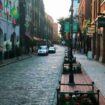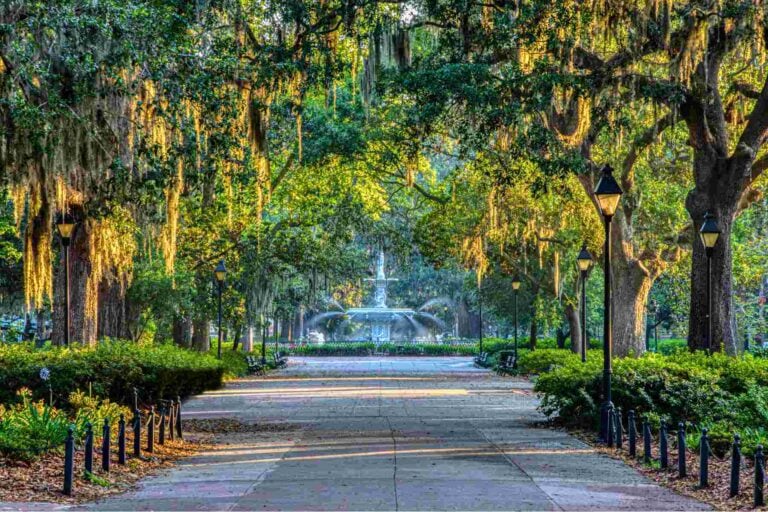
We are reader-supported and may earn a commission on purchases made through links in this article.
Sitting at the lobby bar of the Hyatt Regency on the banks of the Savannah River, we found ourselves swapping travel adventures with a couple on vacation from Chelsea, England. They had pivoted to Savannah, Georgia when their Mississippi River Cruise line declared bankruptcy. After a day exploring its historic district, the wife described it as enchanting. We could not agree more.
Savannah is red brick sidewalks lining cobble-stoned streets which are framed by century-old Live Oaks whose limbs are draped in a curtain of gauzy Spanish moss beckoning the visitor to peak beyond its delicate threads to the magic beyond.
Kathy, my wife, and I had driven to Savannah to celebrate a special anniversary for us and to experience and share in its enchanting aura.
Savannah, Georgia
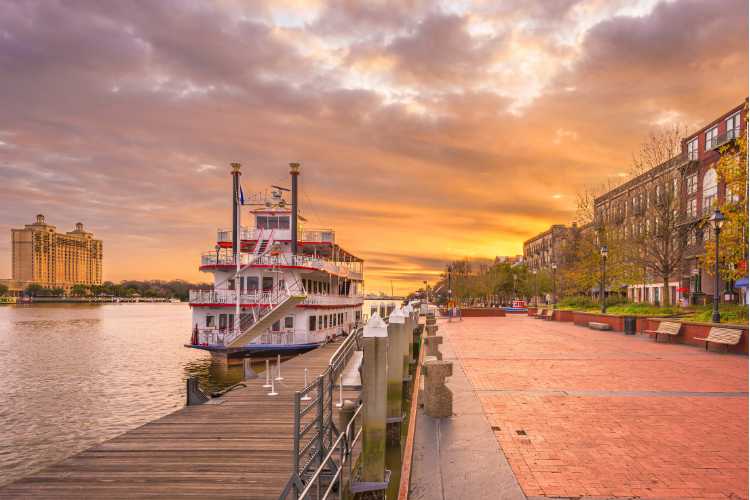
Georgia’s oldest city, is located a little inland from the coast on a bluff overlooking the Savannah River and just across the state line from South Carolina.
After checking in, we headed out to discover what was on the other side of the magical curtain.
In this, one of the oldest cities in America, there remains over two centuries of very visible history in a living, breathing museum. It invites you in to experience its past as the city goes about life at its unique leisurely pace.
We quickly realized that downtown Savannah is immensely walkable allowing us to embrace its unhurried stride. We stepped out, occasionally catching our toes on the picturesque but very uneven red-brick sidewalks.
We soon discovered a unique aspect of Savannah, its parks or Squares as they are known. Each one is distinctive, full of history, and has a charm all of their own.
The Beauty of the Squares
Savannah’s 22 squares are located across a one-square-mile area of downtown, all located within the boundaries of the city’s National Landmark Historic District. They provide locals and visitors with little reminders to stop and embrace the moment and enjoy the miniature escapes in the heart of a city.
All squares contain benches, brick sidewalks, and an abundance of shade trees which bring quick relief from the 80-degree heat that we were experiencing. We marveled at the extensive landscaping and prolific amount of colorful flowers.
As we encountered each new miniature garden, we found ourselves drawn onwards to find the next one with its characteristic wonders and historical surprises. I learned an amazing amount of Savannah’s past just from reading the abundant plaques and placards noting the creation of each particular park and their historical significance.
Best Tips & Tools to Plan Your Trip
Chippewa Square was a favorite of Kathy’s. In the center of the square is the James Oglethorpe Monument honoring the founder of the City. But what intrigued my wife was the fact that the park bench scene (Life is like a box of chocolates) which opens the 1994 film Forrest Gump was filmed on the north side of the Square.
In the heart of the historic district is Colonial Park Cemetery. We walked past its tall wrought iron fence into grounds that were first consecrated in 1750.
Colonial Park Cemetery and Dueling seems to have went hand-in-hand during Colonial Savannah. Many famous duels were said to take place in or near Colonial Park Cemetery
Perhaps the most famous was Button Gwinnett. Gwinnett was most well known for being one of the signers of the Declaration of Independence. Unfortunately he met his end after a duel.
The epitaph to James Wilde, another duelist buried here as a result of the “dueling era” that took place from the 1730s to the 1870s, included the line “My life is like the Summer Rose”
Today visitors walk the paths under the moss-draped trees that tower over the weathered tombstones and the unique above-ground brick tombs and enjoy the serenity, seemingly oblivious of its contents.
Forsyth Park

Eventually, our walks led us to Savannah’s largest square, Forsyth Park. Its 30 acres are a very popular green space. The perimeter of the rectangular park is lined with live oaks and azaleas surrounding expansive lawns.
The northern entrance has the honor of the stunning white-stone Forsyth Fountain. We discovered that Savannah has many beautiful fountains, but none was as striking as the one in Forsyth Park.
The fountain was originally built in 1858 to provide clean drinking water to the citizens of Savannah, during a yellow fever epidemic in the city. It stands at a towering 30 feet above a large marble basin with four spouting decorative statues.
It was quite the attraction for tourists like ourselves. We met two sisters, one from Maryland another from Virginia, with which we shared picture-taking duties of each other.
Owens-Thomas Mansion
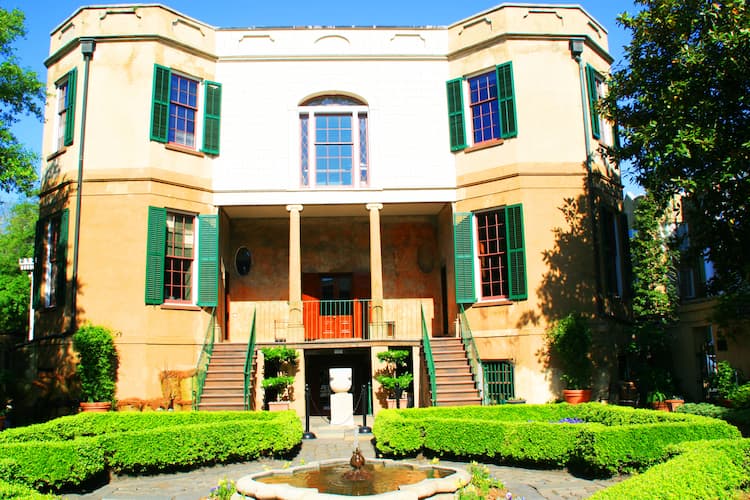
Jovi was animatingly sharing the history of the four walls surrounding us and the lives that resided within. His enthusiasm for the subject was infectious and we could not help but be drawn in. Jovianny, or Bon Jovi without the Bon as he had introduced himself, was sharing the meaning of the names etched on the walls around us. The many names represented helped to shape the history of the Owens-Thomas House but until recently never received the recognition deserved.
Savannah boasts a remarkable architectural heritage that tells a story of its past. Located just off Oglethorpe Square, stands a stately old manor built in 1819, known as the Owens-Thomas House. An impressive two-story structure on a raised basement which George Welshman Owens purchased at auction for $10,000 in 1830.
Over the next 121 years, the home would continue to be owned by the Owens family until the last descendent, Owens’ granddaughter, Margaret Thomas, left the house to the Telfair Academy of Arts and Sciences in 1951.
It was designed by the 26-year-old English architect William Jay. We learned that he designed the house with many interesting architectural elements such as curved walls and doors, indirect lighting in the drawing room, a bridge in the upstairs hall, and one of the finer staircases in the South.
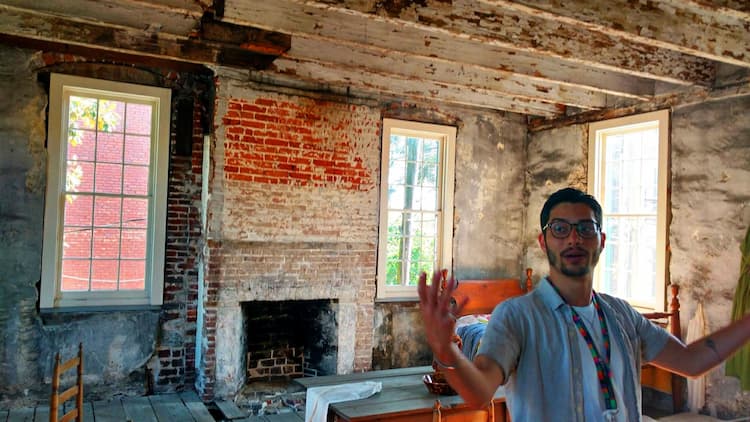
Jovi shared with us that the forward-thinking Mr. Jay introduced some of the first, albeit primitive, indoor plumbing to the home. In order to provide the necessary water to operate, cisterns were incorporated into the house.
But, most haunting were those etched names in the slave quarters which was separate from the main house. Each one represents individuals enslaved by the Richardson and Owens families. Such as Emma, the nanny; Diane, the cook; and Peter, the butler. The Owens-Thomas House & Slave Quarters does not shy away from either the good or the bad of its history.
St. John’s Cathedral
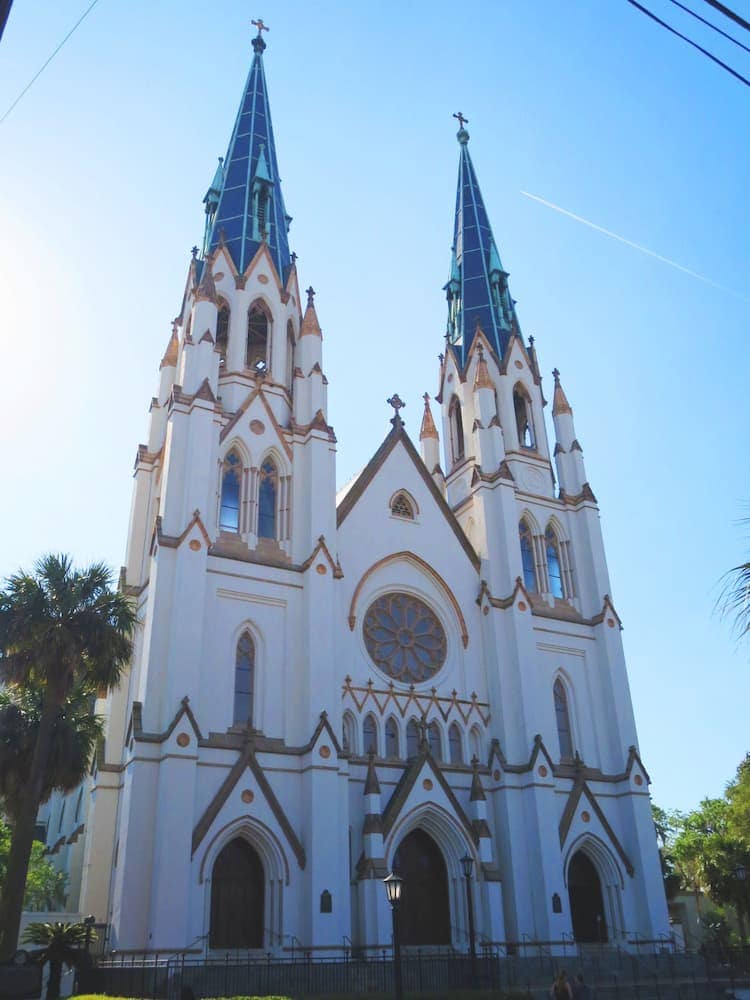
Cathedral Basilica of St. John the Baptist, or St. John’s as it is known to all, has held mass for the faithful and invited non-believers for over a one hundred and fifty years.
Craning our necks upwards, we sought out the tips of the twin spires which reached heavenward into the blue Savannah sky. Each one was adorned with a gold cross which caught the morning sun in a gleaming acknowledgement of what lies within.
Up marble stairs, we entered beneath the Rose Window, a stained-glass welcoming sign.
Past the massive oak doors, a cross-shaped, colossal chamber awaited us. The nave, like a wide marble grand avenue, passed beneath the vaulted roof overhead. It terminated at the immense altar which lies beneath the stunning fresco-painted ceiling.
On either side of the nave sat rows of long wooden pews. Several contained quiet, contemplative worshipers ignoring the camera-toting tourists.
While we stood near the alter, listening to the docent, a life-time member of the congregation, the mighty, oaken organ broke forth in angelic chorus, bringing forth a swelling of emotion that, quite frankly for me, was a little unsettling.
Outside, we reentered the ubiquitous cover of the many live oaks, but as much as they tried, they could not hide the breathtaking masterpiece.
Culinary Delights
The choice of wonderful restaurants in Savannah will spoil you for other cities. Two that we found especially appealing were both easily accessible by foot.
Built in 1771, The Olde Pink House, located at NW corner of Reynolds Square, is one of Savannah’s noted dining establishments. It’s said that a previous owner whitewashed the red brick exterior only to have it bleed through creating a distinctive hue. After several failed attempts to correct the issue, the inevitable was embraced which accounts for the current rosy shade.
On a very busy, warm afternoon we found the dining room full, but were able to snag the last table in the tavern area. After an amazing luncheon of Blue Crab Beignets, Bacon and Fried Green Tomato salad and a cup of She Crab soup, we found ourselves concurring with their reputation for culinary excellence.
I like oysters, and it was hard to ignore the sign for Sorry Charlie’s Oyster Bar. It alone compels you to enter. We happened to enter the three-story restaurant in time for happy hour.
For a view of the setting sun, we chose the rooftop which sits over Ellis Square and the City Market, a popular two-block pedestrian square with restaurants, art galleries, and souvenir shops.
Our effusive waiter recommended the James River Oysters paired with a locally brewed IPA. Hand-cut fries with sea salt and lightly breaded, deep-fried catfish nuggets rounded out an excellent evening.
The River

If the historic district is its heart, Savannah’s life-blood is its river which is the 3rd largest port in the US. This was never more evident as when we, on an afternoon site-seeing cruise aboard the paddle-wheeler Georgia Queen, had to ease aside for a massive ocean going container ship making its way up-river. Announcing its passing, the ship’s booming horn echoed off the banks.
As these floating city-blocks make their way down the waterway they pass in front of River Street.
Each evening we strolled River Street with its ballast stone pavement supplied by long-gone sailing ships. The street fronts ancient brick warehouses that once housed bales of cotton for export.
Today these stout buildings have been converted to an eclectic array of shops, restaurants, taverns and boutique hotels. If you’re looking to buy a Savannah souvenir, have a bowl of shrimp & grits or a frozen daiquiri, River Street is the place to do it.
For a different view, on the bluff above River Street, you can explore Factors Walk.
On the upper reaches of the same four- or five-story cotton warehouses, cotton brokers or “Factors” worked with exporters and managed sales centered on the red terra cotta façade of the Cotton Exchange Building.
Arched, wrought iron bridges provide access from the bluff to cozy cafes, boutiques, and art galleries. If you go, be aware, the stone steps leading to the top are uneven and steep as my wife discovered. Choose the elevator.
Sometimes we would just linger and enjoy a gorgeous view of the Savannah River and do a little ship-watching.
A statue commemorating Florence Martus graces the riverfront. From 1887 to 1931, she greeted ships entering Savannah by waving a cloth at approaching ships. Her fame spread and ships would return her greetings with a blast from the ship’s horn. Many still sound a salute to her statue.
On our final morning, I looked out our window as the sun-streaked its orange rays across the horizon. Delivery drivers unloaded their wares, restocking empty shelves while its crew prepared the Georgia Queen for another magical day in Savannah.
I imagined Florence waving us goodbye or, just maybe, she’s beckoning us back again.
If You Go:
Savannah Georgia is on the southeast coast of the Atlantic Ocean, about two hour’s drive north of Jacksonville, Florida on Interstate 95 or two hours south of Charleston, South Carolina on Interstate 95.
- Visit Savannah | The Official Guide to Savannah, GA
- The Owens-Thomas House & Slave Quarters
- Cathedral Basilica of St. John the Baptist
- The Olde Pink House
- Sorry Charlie’s Oyster Bar
- Georgia Queen River Boat
- Best Hotels in Savannah, GA
Inspire your next adventure with our articles below:
Author Bio: Frank Hosek is an Illinois-based Director of Human Resources who revels in traveling with his wife, Kathy. He enjoys discovering new experiences, meeting the people that make those experiences enjoyable, and sharing their adventures. He is a freelance writer for newspapers and travel websites.

